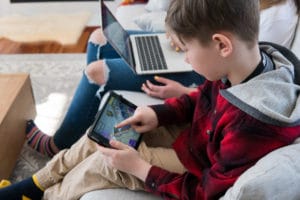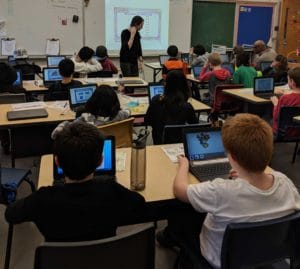Children love play more than anything else. Children go to another world while they play, something that most adults wish we could replicate. Play has many social, emotional, and imaginative benefits for children, but we often lose sight of the educational advantages it offers as well. Leading scientific research shows that kids are at their most focused when they are playing. What opportunities lie in the potential of those moments?
Children learn better through play than anything else. This isn’t completely surprising since the same holds true for almost all mammals. A tiger cub learns to hunt by pouncing on its siblings. Puppies wrestle and roll to practice proper social behaviours. So why is it that we so often try hard to separate learning time from play time? Should they be separate or one in the same?
In today’s blog post, we are going to look at 5 reasons why kids should have the opportunity to learn through play.
1) Play encourages communication.
Often in educational spaces, kids are being told to be quiet and stop talking. Quiet time is important for certain kinds of learning, but kids also need a chance to practice their language skills in many different settings. Giving kids the freedom to play creates opportunities to communicate differently than they would otherwise. For many kids, games become nearly inseparable from real life during play. Because kids take their play so seriously, the richness of those communication skills is heightened, and their impact is deep.

Below the age of 10, many kids only interact with a handful of people outside of their family. But communication can be vastly different between family and peers. . When kids play with their friends, it gives them an opportunity to learn the social expectations of people the same age. Without this crucial understanding, kids will have a harder time being social as they progress through school.
2) Play puts into action and expands on what a kid has already learned.
You can absorb information all you want, but until you put what you have absorbed into action, the learning process is not truly complete. Play gives kids the opportunity to use information and skills they have already encountered and expand on them by practicing in a real-life scenario.

For example: In our game, Dreamscape, kids must learn the instructions on their own as opposed to a classroom setting where their teacher instructs them on the lesson. This gives kids independance that they most likely have not experienced yet. In Dreamscape, kids are walked through a tutorial where they are taught the basics of the game. If the kid chooses to skip through this, they will be left not knowing how to progress and level up in the game. Kids who can read and follow instructions get to put what they have learned into action by reading what the tutorial has to say and then putting those instructions into play once they make it through. Although reading through a tutorial may not seem like an achievement, it can be something that shows kids how important reading the details and following directions are in terms of making progress later down the road.
3) Play makes children happy. Happy kids learn better.

This is a fact that nobody can argue with. If a child is playing with friends, you will almost always see them smiling. Play allows kids to travel to an imaginary world where their brains are stimulated and happiness emerges from the power of imagination. Encouraging play when kids are young increases the likelihood that they will be happy growing up (Barron, 2015.). Adding to this point, it has been proven that kids are much more willing to learn, and learn quicker when they are happy as opposed to sad. Kids who are sad are generally focused on the reasons why they are sad, and thinking about ways that they can resolve these issues. This makes it significantly harder for them to be focused and thus detracts from their learning. Kids who are happy as children are much more likely to succeed in the classroom. It is no surprise really, without the burden of sadness, humans have more enthusiasm and energy, two vital aspects to retaining and understanding information. Looking at play as something that invigorates learning is something more parents and teachers should do. Happy kids = learning classroom.
4) Games allow kids to focus more than any other classroom activity. Many kids have a hard time paying attention to a teacher lecturing at the front of the class for long periods of time. On top of this, distracted kids tend to end up distracting other classmates. Kids today are growing up in a tech-fuelled environment, and it follows that the tools most engaging to them are going to be products of that environment. This is where video games in particular enter the scene. As mentioned above, kids are rarely more focused than they are when at play. Educational video games such as Dreamscape and Prodigy give students the opportunity to use that focus to practice what they have learned in class, while collaborating with other students and having fun! These tools also give the teacher the opportunity to monitor and evaluate the progress of all their students with much less effort and time than it would normally take.
5) By the time children graduate from high school, the average child will have played 12,000 hours of video games.

That is the same amount of time that they would have spent in class, if they had perfect attendance! How crazy is that? Video games have undeniably become a staple in the lives of Generations Z-ers. Some people see this as a calamity, but it can also be seen as an opportunity. What if all of that game time was actually enhancing a child’s education, instead of distracting from it? Many companies have realized the powerful potential of video games for education and are now developing games specifically for that use. With engaging games, kids will choose to use them all on their own and during their spare time. If those games were based around practicing skills outlined in school curricula, that means that kids could actually be excited to do their homework. Kids are already highly engaged with video games. But is there a chance we could turn “practice” and “play” into synonyms?
A great education is made up of many different kinds of teaching and learning. Traditional instruction and play are most powerful when used together, rather than in conflict. . The good news is that in recent years many schools across the world have been open to using technology and gaming in the classroom. These are no longer a part of classrooms-of-the-future, these are classrooms of the now. In fact, 60% of teachers in the US now use digital games at least weekly in teaching (Novotney, 2015.).
Although gaming has been considered a tool for fun, and only fun, for decades, that time is coming to an end. We are moving into a period where kids will be encouraged to play video games in class and at home. A time where gaming and the classroom are one. It may not happen overnight, but slowly and surely it is happening. The result is going to be a generation that is motivated to learn, and has grown up loving the process of learning, and we can’t wait.
Sign up for Dreamscape here: https://go.pardot.com/l/406482/2019-03-04/78zkkr
Our team here at Squiggle Park is incredibly passionate about creating a future where every person has access to education and can become passionate about learning. Here’s to that future.